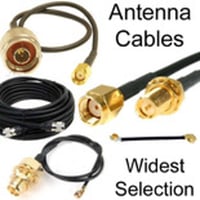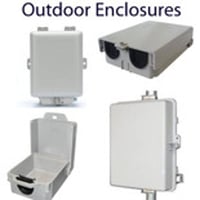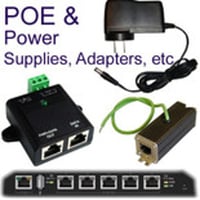RP-TNC Adapters
TNC-RP adapters, joiners, couplers for antenna cables
A Reverse Polarity Threaded Neill-Concelman adapter is a component that is capable of facilitating a competent mechanical and electrical connection between RP-TNC connectors and radio frequency connectors of another type or another RP-TNC connector of the same or differing gender.
- In-series RP-TNC connectors feature straight or right-angled RP-TNC connectors at both ends of the adapter. They may be male-to-male, female-to-male, or female-to-female. They are also known as intra-series connectors.
- Between-series RP-TNC connectors create robust connections between an RP-TNC connector and a connector of a different type, such as SMA and RP-SMA connectors. They are also known as inter-series connectors.
- RP TNC Tee connectors facilitate the connections of three coaxial cables via three male or female connector points in a T shaped arrangement. RP-TNC T connectors enable radio frequency power to be split between two outputs and can be used to attach two antennas to a single feedline.
RP-TNC adapters carry the paired connectors in a single bodied unit, where the complementary connectors can attach to either side. They are designed to provide an impedance-matched connection which maintains the flow of radio frequency energy in the circuit to which they are attached with minimal signal loss.
What is an RP-TNC connector?
The Reverse Polarity Threaded Neill Concelman connector is a variant of the Threaded Neill Concelman (TNC) connector, itself a modification of the original Bayonet Neill Concelman (BNC) coax connector. It is also known as the Threaded Navy Connector and was originally invented by Paul Neill of Bell Labs and Carl Concelman of Amphenol in the late 1950s. The reverse polarity version, described below was developed in the late 1990s to create a radio frequency connector that would comply with the Federal Communications Commission (FCC) restrictions on changing antennas in consumer wireless devices.
The reversed polarity version of the TNC connector has a deliberate swapping of the inner mating interfaces of the male and female connectors. This makes them functionally incompatible with the standard TNC connector which was predominant on professional-grade antennas and wireless networking equipment. Since their initial production RP-TNC connectors have become widely available.
Physical specifications of the RP-TNC connector
The RP TNC connector is a 7/16"-28 threaded, miniature connector that connects by the male connector screwing on top of the female connector. The union is weatherproof making it suitable for outdoor installations. Within the connectors, the inner pin and receptacle form the electrical connection. The threaded connection is strong and able to withstand vibration and other mechanical forces. Repeated coupling and uncoupling can take place without damage to the connectors as they are rated for at least 500 mating cycles. Its diameter is 0.6 inches (15.24 millimeters) and the length is 1.23 inches (31.24 millimeters). Its body is made from nickel-plated brass with a PTFE (Teflon) insulator and gold-plated inner contacts.
- The male RP-TNC connector has internalized threads, and unlike the standard TNC connector, has an internal mating interface that carries a receptacle rather than a pin.
- The female RP-TNC connector has a threaded barrel with externalized threads with an inner pin.
Electrical specifications of the RP-TNC connector
RP-TNC connectors deliver reliable microwave connectivity with a frequency range of up to 11 GHz. The maximum operating voltage is 500 volts and the impedance is 50 Ohms. Its Voltage Standing Wave Ratio is 1.3 and its radio frequency leakage is -60 dB at 3 GHz.
Why are RP-TNC adapters important?
RP-TNC adapters provide a quick and accessible means of changing the gender or type of radio frequency connector on antennas and coaxial cable assemblies. They not only facilitate connections between connectors that otherwise cannot mate but also can be used to protect connectors on equipment where the number of mating cycles will be high. The adapter can therefore be used to protect connectors from wearing out as the adapter that can be readily replaced, leaving the connectors preserved. Such adapters are called connector savers. Good quality brass connectors with resilient nickel-plating and gold, silver, or copper-coated contacts deliver good electrical continuity and performance needed to maintain connectivity in different types of radio frequency circuits and across a range of settings. Straight RP-TNC connectors also work well with panel mounted or bulkhead connectors as they minimize disruption to the installed connectors. RP-TNC adapters provide good electrical performance with a comparable VSWR to the connector, though the frequency range is may be lower than the RP-TNC connector itself. Radio frequency connector adapters can also save money and time in making an antenna or radio device compatible with existing cable assemblies or other equipment.
Applications where the RP-TNC connector adapter may be needed
The RP-TNC connector was created for wireless networking equipment so it is a highly prevalent connector termination on WiFi equipment such as antennas, wireless routers, and base stations. Its resilient threaded structure also makes it useful for industrial settings where the connection may have to withstand strong mechanical forces. Coaxial interface conversion or coaxial retrofit applications using an RP-TNC adapter allows the connection of antennas via an RP-TNC connector or coaxial cable. RP-TNC adapters can facilitate connection with the other classes of connectors commonly used for WiFi and other forms of wireless networking, particularly the N-type, RP-SMA, and SMA connectors.
Frequently asked questions
What are the benefits of threaded connectors and adapters?
Connectors that have a coupling mechanism with threads and often a coupling nut are advantageous for creating a robust connection that provides reliable performance.
Threaded connections are slower to make because they need to be screwed but the connection tends to be weatherproof, with high mechanical strength and stability in environments with high vibration or movement. Threaded RP-TNC adapters confer these structural benefits.
When coupling a threaded connector optimal performance is gained by tightening to the maximum permitted torque.
In conclusion
As RP-TNC connectors are widely used for wireless networking, RP-TNC adapters are necessary to make mechanically and electrically sound connections between antennas and other radio frequency equipment that carry and RP-TNC connector or facilitate compatibility with other types of connector.
LEARN MORE:







